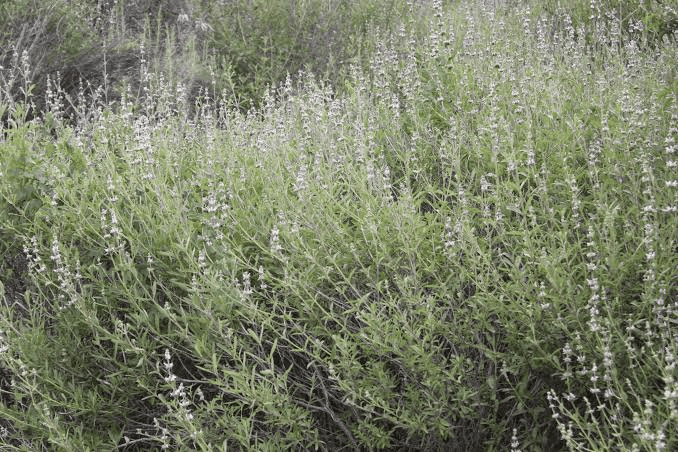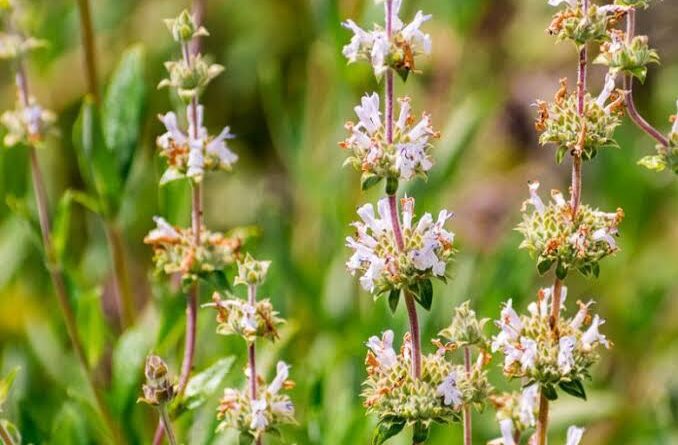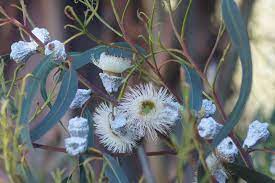7 Medicinal Health Benefits Of Salvia mellifera (Black Sage)
Salvia mellifera, commonly known as Black Sage, is a perennial shrub native to the western United States. This botanical marvel is characterized by distinct features that make it stand out in the wild landscape.
The Botanical Description of Salvia mellifera (Black Sage)
Appearance: Black Sage typically grows to a height of 2 to 4 feet (0.6 to 1.2 meters) and spreads to a width of about 4 to 6 feet (1.2 to 1.8 meters). It boasts a compact and bushy appearance, with woody stems that are covered in dark gray to blackish bark.
Leaves: The leaves of Black Sage are striking and aromatic. They are narrow, oblong, and covered in fine hairs. The upper leaf surface is dark green, while the lower surface is lighter in color. When crushed or brushed against, the leaves emit a fragrant scent, which is a key characteristic of the plant.
Flowers: Black Sage produces clusters of tubular, two-lipped flowers that are typically lavender to purple in color. These blooms are arranged in dense, elongated spikes at the tips of the branches. They are a source of nectar for pollinators, especially bees and butterflies.
Habitat: This drought-tolerant shrub is well-suited to arid and semi-arid regions. It can be found in a variety of habitats, including chaparral, coastal sage scrub, and desert ecosystems. Black Sage often thrives in rocky or sandy soils.
Growing Conditions: Black Sage is adapted to the Mediterranean climate of its native range, characterized by hot, dry summers and mild, wet winters. It is well-suited for xeriscaping, as it requires minimal water once established.
The Geographic Distribution of Salvia mellifera (Black Sage)
Salvia mellifera, commonly known as Black Sage, is native to the western United States, primarily found in California and neighboring regions. Its geographic distribution is characterized by the plant’s adaptation to a variety of habitats within this range.
1. California: Black Sage is most abundant in California, where it is a prominent feature of the state’s diverse ecosystems. It can be found in both southern and central parts of California, including regions with a Mediterranean climate.
2. Baja California: The plant extends into the northern regions of Baja California, Mexico, where it thrives in similar arid and coastal environments.
3. Desert Ecosystems: Black Sage is well-suited to desert ecosystems, including the Mojave Desert and the Sonoran Desert. Its ability to tolerate low water availability makes it a resilient species in these regions.
4. Chaparral Habitats: Black Sage is a common component of chaparral habitats, which are characterized by dense, woody shrubs and a Mediterranean climate. It often shares these habitats with other native plants.
5. Coastal Sage Scrub: Along the California coast, Black Sage can be found in coastal sage scrub ecosystems, where it contributes to the unique biodiversity of these areas.
6. Dry Slopes and Rocky Soils: This plant thrives in well-drained, rocky soils and on slopes, making it adaptable to a range of soil conditions.
7. Altitudinal Range: Black Sage can be found at varying elevations, from sea level to higher elevations, contributing to its wide distribution.
The geographic distribution of Black Sage is a testament to its resilience and adaptability to different environments. Its presence in California and adjacent regions makes it a valuable species in local ecosystems and a subject of interest for conservation efforts.
The Chemical Composition Of Salvia mellifera (Black Sage)
Salvia mellifera, commonly known as Black Sage, is valued not only for its aromatic leaves and traditional uses but also for its diverse chemical composition. This composition contributes to its medicinal properties and potential health benefits. While the chemical constituents can vary among individual plants, the following compounds are commonly found in Black Sage:
1. Essential Oils: Black Sage leaves contain essential oils, which are responsible for the plant’s characteristic fragrance. These oils are rich in compounds such as thujone, cineole, and camphor. Thujone, in particular, is known for its mild psychoactive effects.
2. Terpenes: Black Sage contains various terpenes, including limonene, myrcene, and pinene. Terpenes contribute to the plant’s aromatic qualities and may offer potential health benefits.
3. Phenolic Compounds: Phenolic compounds, such as rosmarinic acid, are present in Black Sage. These compounds are known for their antioxidant properties, which can help combat oxidative stress in the body.
4. Flavonoids: Black Sage contains flavonoids like quercetin and kaempferol. Flavonoids are antioxidants that can have various health benefits, including anti-inflammatory effects.
5. Tannins: Tannins, a group of polyphenolic compounds, are found in Black Sage. They are known for their astringent properties and may contribute to the plant’s traditional uses for digestive health.
6. Alkaloids: While present in smaller amounts, alkaloids like nicotine and anabasine have been detected in Black Sage. These alkaloids may have insecticidal properties and can deter herbivores.
7. Monoterpenes: Monoterpenes, such as α-pinene and β-pinene, are common in Black Sage. These compounds have a role in the plant’s aroma and may have potential therapeutic properties.
It’s important to note that the concentration of these compounds can vary based on factors such as plant age, environmental conditions, and geographic location. The diverse chemical composition of Black Sage provides a foundation for its various applications, from traditional medicine to aromatherapy.
The Harvesting and Processing of Salvia mellifera (Black Sage)
Harvesting and processing Black Sage, scientifically known as Salvia mellifera, is a practice that involves care and respect for the plant and its ecosystem. This guide outlines the steps involved in sustainably harvesting and processing Black Sage.
1. Selecting the Right Time: The timing of harvesting is crucial. It’s best to harvest Black Sage when it’s in full bloom, typically in late spring to early summer. This is when the plant’s essential oil content is at its highest.
2. Use Pruning Shears: When harvesting, use sharp pruning shears or scissors to make clean cuts. Avoid tearing or damaging the plant, as this can affect its regrowth.
3. Leave Enough Foliage: When pruning, be sure to leave a significant portion of foliage on
the plant. Black Sage relies on its leaves for photosynthesis and growth. It’s essential to maintain the health of the plant for future harvests.
4. Dry the Harvested Branches: After harvesting, tie the branches together in small bundles and hang them upside down in a dry, well-ventilated area. This allows the leaves to dry slowly and retain their aromatic qualities.
5. Avoid Direct Sunlight: While drying, protect the bundles from direct sunlight, as prolonged exposure to sunlight can cause the essential oils to evaporate.
6. Store in a Cool, Dark Place: Once the leaves are thoroughly dried, store them in airtight containers in a cool, dark place. This helps preserve the quality of the dried leaves.
7. Sustainable Harvesting: It’s crucial to practice sustainable harvesting. Avoid overharvesting, which can harm the plant population. Harvest from multiple stands to distribute the impact.
8. Respect Indigenous Practices: If you’re harvesting Black Sage on lands with indigenous significance, it’s essential to respect local traditions and practices related to the plant. Consult with local communities and tribal authorities if necessary.
9. Ethical Considerations: Keep ethical considerations in mind. Sustainable harvesting and processing should prioritize the well-being of the plant and its natural habitat.
Processing Black Sage with care and sustainability in mind ensures that this valuable plant continues to thrive in its native habitats and provides benefits to both ecosystems and human well-being.
Read Also: 18 Medicinal Health Benefits Of Mahonia nervosa (Longleaf Oregon Grape)
The Medicinal Health Benefits Of Salvia mellifera (Black Sage)

Salvia mellifera, commonly known as Black Sage, has a rich history of traditional medicinal uses, offering a range of health benefits. These benefits are attributed to its diverse chemical composition, making it a valuable plant in traditional healing practices and modern herbal medicine. Here are some of the key medicinal health benefits of Salvia mellifera:
1. Respiratory Health: Black Sage has a long history of use in treating respiratory issues. Inhaling the aromatic vapors of Black Sage tea or its essential oil can help alleviate symptoms of congestion, coughs, and colds. It acts as a natural decongestant and expectorant, facilitating easier breathing.
2. Anti-Inflammatory Properties: Black Sage contains phenolic compounds and flavonoids with potent anti-inflammatory effects. These properties make it valuable in reducing inflammation in the body, potentially aiding in the management of inflammatory conditions.
3. Digestive Aid: Traditional herbalists have used Black Sage to support digestive health. It may help relieve indigestion and bloating. The plant’s tannins can have a mild astringent effect on the digestive system.
4. Relaxation and Stress Relief: Black Sage is known for its soothing and calming properties. It can be brewed into a tea that promotes relaxation, making it useful for stress relief and anxiety reduction. Its mild psychoactive compounds can induce a sense of tranquility.
5. Antioxidant Protection: The flavonoids and phenolic compounds found in Black Sage act as antioxidants, combating free radicals and oxidative stress. This can contribute to overall health and may help prevent chronic diseases.
6. Wound Healing: Traditionally, Black Sage leaves have been used topically to aid in wound healing. Their antiseptic properties may help prevent infection, while the plant’s anti-inflammatory effects can reduce swelling.
7. Pain Relief: Black Sage has been used as a natural analgesic to alleviate minor aches and pains. It may be applied topically as a poultice or used in aromatherapy for pain relief.
The Methods of Usage to Achieve the Provided Health Benefits Of Salvia mellifera (Black Sage)
To harness the medicinal health benefits of Salvia mellifera, or Black Sage, various methods of usage can be employed. Here are some common approaches to achieve the provided health benefits:
1. Black Sage Tea: The most traditional method involves brewing Black Sage leaves into a tea. Steep a handful of dried leaves in hot water for a soothing beverage that can address respiratory issues, digestive discomfort, and stress relief.
2. Inhalation: Inhaling the vapor from a steaming cup of Black Sage tea or using its essential oil in a diffuser can help clear nasal congestion and promote relaxation.
3. Topical Application: To aid in wound healing or relieve localized pain, create a poultice using crushed Black Sage leaves and apply it to the affected area. Remember to clean the wound before applying the poultice.
4. Aromatherapy: Diffusing Black Sage essential oil in your living space can create a calming atmosphere and promote relaxation. It’s particularly useful for stress relief.
5. Smoke Cleansing: Black Sage is used in Native American traditions for smoke cleansing rituals. The fragrant smoke is believed to purify spaces and ward off negative energies.
6. Tinctures and Extracts: Some individuals prefer tinctures and extracts, which can provide a concentrated form of the plant’s medicinal compounds. Follow dosage instructions carefully.
7. Culinary Use: While primarily used for its medicinal properties, Black Sage can also be used as a culinary herb, adding flavor to dishes such as soups and stews.
The Side Effects Of Using Salvia mellifera Medicinal Plant
While Black Sage offers numerous health benefits, it’s important to be aware of potential side effects and precautions:
1. Allergic Reactions: Some individuals may be allergic to plants in the Salvia genus. If you experience itching, swelling, or difficulty breathing after using Black Sage, discontinue use and seek medical attention.
2. Thujone Content: Black Sage contains thujone, a compound that can be toxic in high concentrations. While the thujone content in Black Sage is relatively low, excessive use should be avoided.
3. Pregnancy and Nursing: Pregnant and nursing women should use Black Sage with caution. Limited information is available regarding its safety during these periods, so consult a healthcare professional before use.
4. Psychoactive Effects: Black Sage’s mild psychoactive properties may cause drowsiness or altered consciousness. It’s essential not to use it before or while operating machinery or driving.
5. Medication Interactions: If you’re taking medications, consult with a healthcare provider before using Black Sage, as it may interact with certain drugs.
As with any herbal remedy, it’s advisable to consult with a healthcare professional before incorporating Black Sage into your wellness routine, especially if you have specific health conditions or concerns.
Read Also: Steps to Successful Pasture Establishment for Optimum Performance
The Scientific Research and Studies of Salvia mellifera (Black Sage)

Scientific research on Salvia mellifera, or Black Sage, has revealed intriguing insights into its medicinal properties. Several studies have explored its chemical composition and therapeutic potential. Researchers have identified various compounds within Black Sage, including flavonoids, phenolic acids, and essential oils. These components contribute to its antioxidant, anti-inflammatory, and antimicrobial properties. Studies have shown that Black Sage’s extracts exhibit significant free radical-scavenging activity, indicating its potential in preventing oxidative stress-related diseases. Additionally, research has explored its traditional uses among Native American communities, shedding light on its cultural significance and historical healing practices.
The Safety Precautions and Recommendations In Using Salvia mellifera (Black Sage) Medicinal Plant
While Salvia mellifera, or Black Sage, offers several health benefits, it’s crucial to prioritize safety when using this medicinal plant:
1. Dosage and Duration: Use Black Sage in moderation and adhere to recommended dosages. Prolonged or excessive use may lead to adverse effects.
2. Allergic Reactions: Individuals allergic to plants in the Salvia genus should avoid Black Sage. If allergic symptoms such as itching, swelling, or difficulty breathing occur, discontinue use and seek medical help.
3. Thujone Content: Black Sage contains thujone, a compound that can be toxic in high doses. While the thujone content in Black Sage is relatively low, avoid excessive consumption.
4. Consultation: If you are pregnant, nursing, taking medications, or have underlying health conditions, consult a healthcare professional before using Black Sage for medicinal purposes.
5. Psychoactive Effects: Black Sage has mild psychoactive properties. Avoid activities that require full attention, such as driving or operating heavy machinery, after using Black Sage.
6. Interactions: Black Sage may interact with certain medications. It’s essential to consult a healthcare provider if you are taking medications to prevent potential interactions.
FAQs About Salvia mellifera (Black Sage) Medicinal Plant
Q1: Can Black Sage be used by pregnant or nursing women?
A1: Pregnant and nursing women should exercise caution when using Black Sage. Limited information is available regarding its safety during these periods, so consulting a healthcare professional is advisable before use.
Q2: Can Black Sage be used for children?
A2: It’s best to avoid administering Black Sage to children without consulting a healthcare provider. Dosage and safety considerations may vary based on the child’s age and health status.
Q3: Is Black Sage safe for individuals with allergies?
A3: Individuals allergic to plants in the Salvia genus, such as sage, should avoid Black Sage. Allergic reactions may include skin irritation, swelling, or respiratory issues.
Q4: Can Black Sage interact with medications?
A4: Yes, Black Sage may interact with certain medications. If you are taking prescription drugs, it’s essential to consult a healthcare provider before using Black Sage to prevent potential interactions and adverse effects.
Q5: How should Black Sage be stored?
A5: Store dried Black Sage leaves in an airtight container away from direct sunlight and moisture. Proper storage helps maintain its potency for medicinal use.
Remember, while Black Sage has numerous potential benefits, individual responses can vary. It’s crucial to approach its usage with care, especially if you have specific health conditions or concerns.
Read Also: Comprehensive Farming Guide For Starters








